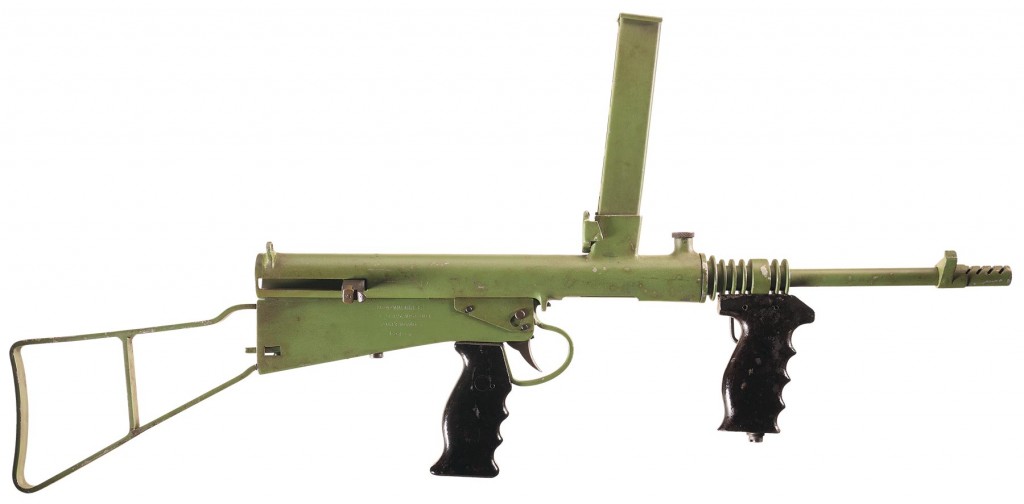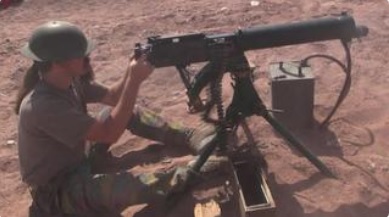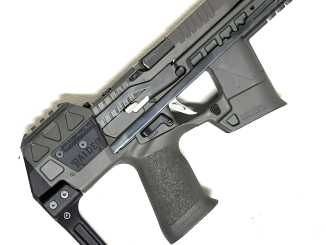Continuing yesterday’s post, today I want to take a look at some of the long guns that jumped out at me while I was perusing the catalog for the RIA Premier Auction coming up in two weeks (September 13th-15th).
First up, I noticed a pretty nice selection of early American bolt-action rifles. The US military had run trials with repeating rifles (other than lever-actions) in 1872 and 1878, and a bunch of interesting guns were submitted. None were chosen for major use by the military, but a bunch of them went into at least limited commerical production. The ones in this catalog include:
Remington-Keene (Lot 3332) in .43 Spanish. About 5000 of these rifles were made between 1877 and 1888, including a few hundred in .45-70 for the Indian Bureau.

Winchester-Hotchkiss, model 1883 (Lot 3329) and earlier model 1879 (Lot 3347). Both in .45-70, the Hotchkiss design used a tube magazine in the buttstock. The early version was loaded from the rear (like a Spencer), while the later version was loaded through the action, pushing cartridges case-first into the tube. I narrowly missed winning an 1883 model Winchester-Hotchkiss at the last RIA auction…


Remington-Lee, in .30-40 caliber (Lot 1332). The US Navy trialed James Paris Lee’s bolt-action rifle in 1881/2, and Remington continued to produce them for export and commercial markets. This one is a commercial gun or the 1899 pattern (they were also offered in 6mm Lee Navy, .30-30, 7mm Mauser, 7.65mm Mauser, .32 Winchester, .32-40, .35 Remington, .38-72, .43 Spanish, .44-77, and .45-70).

Chaffee-Reese model 1884 (Lot 3321 and Lot 3337). Externally very similar to the early Winchester-Hotchkiss, just 753 examples of the Chaffee-Reese were made at Springfield Armory. It used a tube magazine in the stock, but with an escalator-type loading system instead of a magazine spring. Retracting the bolt would push a long stepped rack down past the stack of cartridges, and closing the bolt would pull the stack up by one round, chambering the top round in the process. This prevented bullet tips form contacting primers as in other tube mag designs, but the gun was plagued by parts breakages in testing.

Winchester-Lee Navy, model 1895 (Lot 1331 , Lot 1335, Lot 1329, Lot 3320). A totally different design by James Lee, the 1895 Navy rifle was a basically straight-pull design in which the bolt is pulled slightly up and back to unlock. These rifles were accepted by the Navy is an ahead-of-its-time smallbore 6mm cartridge. Unfortunately, the design was not well-liked and it had some persistent problems, and was retired from service in 1904.

There are other examples of a few of these in the auction catalog, but you’ll have to go ferret them out yourself. 🙂 Moving on to a few other items…
A 1940 Smith & Wesson Light Rifle (Lot 1831) – a semiauto 9mm carbine made for the British when they were in dire need of arms early in WWII. It turned out to be a downright terrible design; heavy, fragile, and nearly impossible to clear malfunctions from – but still interesting from a historical perspective and quite rare, since the Brits dumped most of them into the ocean.

Another one for the financially well-endowed collector is a 1908 Mondragon selfloader (Lot 3525). Generally (although incorrectly) considered the first semiauto rifle adopted by a military power, these were first purchased by the Mexican Army, which bought 400 and then cancelled the rest of the order when they realized the guns required better quality ammo than Mexico had access to. The remainder were sold to Germany, where they were used briefly to arm balloons and aircraft crews.

There are a bunch of other cool treasures in the auction, but I don’t have the space to cover everything – and besides, that would take the fun out of delving into the catalog yourself! I’ll close this out with a not-so-common submachine gun: an Australian MkI Owen Gun (Lot 303). Despite is appearance, the Owen is arguably the best subgun of WWII – and extremely rare in the US (or Australian, for that matter). The catalog description was a bit vague, so I confirmed with RIA that it is in fact a fully transferrable (and C&R eligible) gun.
Good luck bidding, guys! I’ll be dropping in on the open house day prior to the actual auction, so I will be bringing you some video on some of the particularly cool an unusual items in a few weeks…





The economy must be booming, a lot of these have estimates double of what I’d thought. That Mondragon is a beauty, but 14k the low end of the price range?
Unfortunately, it wouldn’t really surprise me if a significant portion of the bidders on some of these are wealthy folks looking for an investment to park some money in. Not that wealthy folks shouldn’t have cool guns, but a gun bought as an investment and packed away is a loss to the community, when it could be in the hands of someone who can share and appreciate it.
And therein lies the quandary we have to live with. I have no objections if someone of an elevated income status purchases a collector-grade weapon out of sincere historical intent — for the simple reason that a genuine and sincere enthusiast of this ilk would probably have no qualms in sharing said weapon and his / her experiences with it, as with any other such enthusiast — but it would be an entirely different story if the same individual were doing so strictly as a money-making “investment” with no eye toward the true value of that firearm, i.e., its historical viability and what that means to society at large. It is so unfortunate that money, and the desire for money, seems to corrupt processes that should stand far above it.
I absolutely LOVE the Model 1883 Winchester-Hotchkiss and 6mm Lee Navy! I just wish I had anything like the money to buy either of them.
I saw the complete 1903 with Peterson Device with original metal case and I had a bit of a moment…. My collection is all of a sudden very lacking….
Neat stuff, I love tube fed bolt guns. That Owen is also really fascinating.
Ian, in your opinion, how does the Owen compare to the Sten in terms of ease of manufacture?
The Owen is definitely not as cheap to make as the Sten, but it works a lot better.
According to Wayne Wardman in his book ‘The Owen Gun’, in 1942 an Owen Mk 1 took 20 hours to manufacture, while the Austen Mk 1 (Australian Sten) took 12 hours to manufacture. Considering that the Austen was significantly more complex than a Sten Mk 2, an Owen may have taken at least three times as long to manufacture, I suspect. And while the Owen is very rare in private hands, they occasionally come up for sale here in Australia, but there are many on show in museums around the country. I believe the bulk of the 50,000 that were made ended up in the Pacific Ocean over 30 years ago. It has been said that fishermen occasionally would find one in their nets.
PV, thanks for sharing a rare bit of history from the other side of the globe, and from a significant but ( unfortunately ) all-too-easily forgotten era. It is almost physically painful to read about the post-war disposal of the bulk of the Owen inventory, although I am sure ( please correct me if I am wrong ) the authorities of the time were only doing what they thought ( rightly or wrongly ) was best.
Shooting for the S&W 1940. It would look good beside my S&W M76. Or even my British WW 2 collection. Not going to get my hopes up. Last one I bid on went through the roof.
Good luck!
Ive been told that the failure of the SW lite rifle was made right by Smith and Wesson by manufacturing bunches M&P revolvers for them in .38 smith. Seemed the brits had paid for at least some of the rifles in advance and then didn’t accept them cause they were junk. Can anyone confirm this story.
What I found interesting were the Swiss sniper rifles. Given that regular Swiss infantry rifles are so accurate that I feel like they’re laughing at me when I shoot at targets under 400 meters away, I’d love to experience shooting one of the sniper versions.
http://www.rockislandauction.com/viewitem/aid/59/lid/580
http://www.rockislandauction.com/viewitem/aid/59/lid/1537
http://www.rockislandauction.com/viewitem/aid/59/lid/1536
http://www.rockislandauction.com/viewitem/aid/59/lid/3531
http://www.rockislandauction.com/viewitem/aid/59/lid/3532
But unfortunately, I don’t have that kind of money to spare.